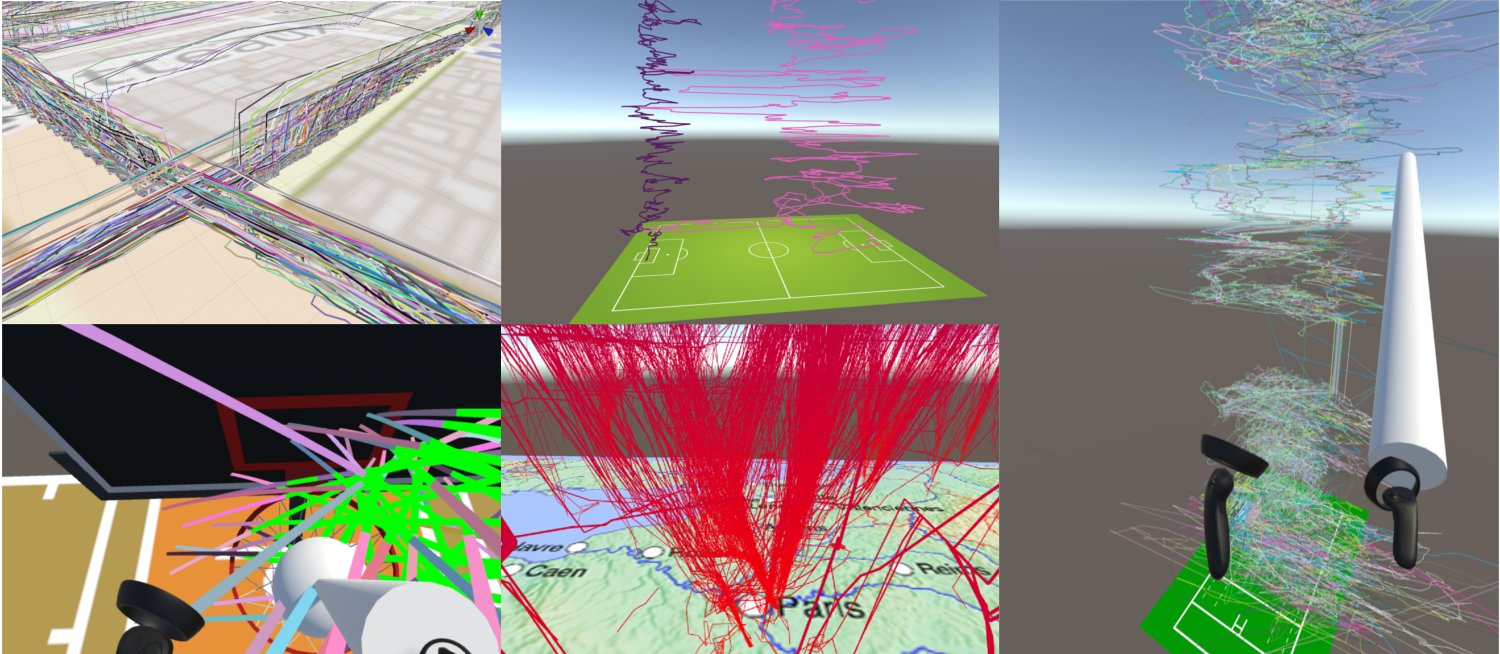Github Repository - PAr 118 - ReViVD (2018-2019)
Full name: 3D data exploration with Virtual Reality Headset (aircraft trajectories, sports data)

ReViVD's main objective is to develop new 3D data visualization and exploration tools in Virtual Reality. We intend to showcase methods of interacting with data in VR which are simply not possible in other desktop configurations.
Some documentation can be found on our website.
/*
json file example for airtraffic data adapted from http://recherche.enac.fr/~hurter/FromDaDy.html
This json file describes your binary file to let ReViVD know how to read your dataset.
*/
{
//The path attribute names to use as id and/or as number of atoms, keep it void ("") if it doesn't apply to your dataset. The names must match with the ones in the path attributes array of this json.
"pathAttributeUsedAs_id": "id",
"pathAttributeUsedAs_n_atoms": "n",
//The atom attribute names to use as x, y, z (mandatory) and/or as t and color, keep it void ("") if it doesn't apply to your dataset. The names must match with the ones in the atom attributes array of this json.
"atomAttributeUsedAs_x": "x",
//y attribute is the vertical axis (toward the sky)
"atomAttributeUsedAs_y": "altitude",
"atomAttributeUsedAs_z": "z",
"atomAttributeUsedAs_t": "t",
"atomAttributeUsedAs_color": "altitude",
//Name of the binary file to load, must be in the same folder of this json file.
"filename": "airtraffic",
//If you have several binary files split by instants, turn the following option to true, set the number of instants per file and fill in the suffix of the first file (assuming that it is an incremental int)
"severalFiles_splitInstants": false,
"splitInstants_instantsPerFile": 50,
"severalFiles_firstFileSuffix": "0001",
//Binary endianness
"endianness": "little",
/* District size of the visualization
* Used for collision detection optimization with selectors
* Bigger districts are generally better for big selectors
* Smaller districts are generally better for small selectors and very atom-dense visualizations
* Try to fiddle around with those values if you find selection performance lacking.
* Cubical districts are not mandatory but will go faster, especially on isotropic visualizations;
* However, if a visualization is very atom-dense on only one axis, try reducing the district size on that axis.
*/
"districtSize": {
"x": 40.0,
"y": 40.0,
"z": 40.0
},
//Coordinates of the lower truncature point
"lowerTruncature": {
"x": -10000.0,
"y": -10000.0,
"z": -10000.0
},
//Coordinates of the upper truncature point
"upperTruncature": {
"x": 10000.0,
"y": 10000.0,
"z": 10000.0
},
//Number of paths in the entire dataset
//Can be left blank / too large if unknown, at your own risks.
"dataset_n_paths": 4309,
//Display all paths in the dataset if set to true.
"allPaths": true,
//If allPaths is false, those paramaters handle the sampling of paths.
"randomPaths": false,
"chosen_n_paths": 4309,
"chosen_paths_start": 0,
"chosen_paths_end": 4309,
"chosen_paths_step": 1,
//Number of instants in the dataset, set it to a large number or leave it blank if unknown.
//Will be overriden by pathAttributeUsedAs_n_atoms if it is defined.
"dataset_n_instants": 2147483647,
//Display all instants in the dataset if set to true.
"allInstants": true,
//If allInstants is false, those paramaters handle the sampling of instants.
"chosen_instants_start": 0,
"chosen_instants_end": 200,
"chosen_instants_step": 1,
//If true x and z axis will be interpreted as latitude and longitude (decimal degree)
"useGPSCoords": false,
//Set the origin of the visualization to be at these specific GPS coordinates
"GPSOrigin": {
"x": 0.0,
"y": 0.0
},
//Control of the parameters of the spheres animation: radius, animation speed, beginning time of the animation and if spheres are display.
"spheresRadius": 2.0,
"spheresAnimSpeed": 1.0,
"spheresGlobalTime": 0.0,
"spheresDisplay": false,
//array of asset Bundles to load with the visualization, keep it empty ([]) if it doesn't apply to your dataset.
"assetBundles": [
{
//Name of the asset bundle
"name": "airtraffic_map",
//Filename of the asset bundle to load, must be in the same folder of this json file.
"filename": "airtraffic_map",
//If set to true, let you override the position, rotation and scale of the asset bundle.
"overrideBundleTransform": false,
"position": {
"x": 0.0,
"y": 0.0,
"z": 0.0
},
"rotation": {
"x": 0.0,
"y": 0.0,
"z": 0.0
},
"scale": {
"x": 0.0,
"y": 0.0,
"z": 0.0
}
}
],
//Path attributes array, keep it empty ([]) if it doesn't apply to your dataset.
"pathAttributes": [
{
//Name of the attribute, if the attribute is used as id or n_atoms the names must match!
"name": "id",
//Type of the attribute : int32, float32, int64 or float64.
"type": "int32"
},
{
"name": "n",
"type": "int32"
}
],
//Atom attributes array.
"atomAttributes": [
{
//Name of the attribute, if the attribute is used as x, y, z, t or color the names must match!
"name": "t",
//Type of the attribute : int32, float32, int64 or float64.
"type": "float32",
//Position offset if the attribute is used as an axis
"positionOffset": 0.0,
//Size multiplier if the attribute is used as an axis; applied after position offset
"sizeCoeff": 1.0,
//Those parameters handle the color interpolation if this attribute is used as color
"colorStart": "Blue",
"colorEnd": "Red",
//If set to true, color interpolation is done between the min and max values of this attribute
"valueColorUseMinMax": false,
//If valueColorUseMinMax is false, color interpolation is done between those two values
"valueColorStart": 0.0,
"valueColorEnd": 1.0
},
{
"name": "x",
"type": "float32",
"positionOffset": 0.0,
"sizeCoeff": 1.0,
"colorStart": "Blue",
"colorEnd": "Red",
"valueColorUseMinMax": true,
"valueColorStart": 0.0,
"valueColorEnd": 1.0
},
{
"name": "z",
"type": "float32",
"positionOffset": 0.0,
"sizeCoeff": 1.0,
"colorStart": "Blue",
"colorEnd": "Red",
"valueColorUseMinMax": true,
"valueColorStart": 0.0,
"valueColorEnd": 1.0
},
{
"name": "altitude",
"type": "float32",
"positionOffset": 0.0,
"sizeCoeff": 1.0,
"colorStart": "Blue",
"colorEnd": "Red",
"valueColorUseMinMax": true,
"valueColorStart": 0.0,
"valueColorEnd": 1.0
}
]
}